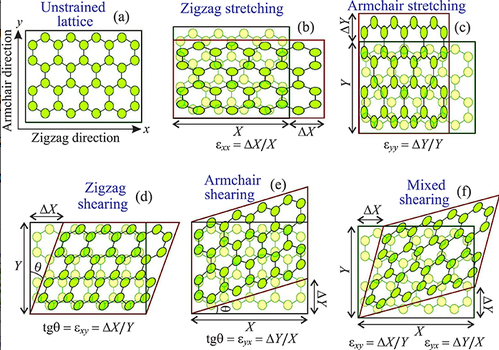The possibility of inducing a sizeable energy gap in the electronic structure of a graphene layer is still one of the biggest and most debated challenges in graphene electronics. Despite promising theoretical results, some experimental studies report the absence of a bandgap even in highly mechanically strained graphene. In this paper, we address the main reasons for these discrepancies and study the influence of uniaxial tensile and shear strains as well as their combinations on the eventual bandgap opening in monolayer graphene. Deformation-dependent bandgap diagrams are constructed over a wide range of the strain tensor parameters of up to 26%, which is close to predicted graphene breaking point. The use of a combination of shear strain and uniaxial tensile deformations is found to be the easiest way for bandgap opening and tuning. The results of our numerical calculations demonstrate that shear strains can induce a bandgap of up to 4 eV at the largest elastic deformations, while a combination of shear and uniaxial strains can provide an energy gap of up to 6 eV that is substantially higher than for some materials (including silicon) typically used in nanoelectronic devices. The numerically obtained findings are carefully contrasted with other results available in the literature.

The possibility of inducing a sizeable energy gap in the electronic structure of a graphene layer is still one of the biggest and most debated challenges in graphene electronics. Despite promising theoretical results, some experimental studies report the absence of a bandgap even in highly mechanically strained graphene. In this paper, we address the main reasons for these discrepancies and study the influence of uniaxial tensile and shear strains as well as their combinations on the eventual bandgap opening in monolayer graphene. Deformation-dependent bandgap diagrams are constructed over a wide range of the strain tensor parameters of up to 26%, which is close to predicted graphene breaking point. The use of a combination of shear strain and uniaxial tensile deformations is found to be the easiest way for bandgap opening and tuning. The results of our numerical calculations demonstrate that shear strains can induce a bandgap of up to 4 eV at the largest elastic deformations, while a combination of shear and uniaxial strains can provide an energy gap of up to 6 eV that is substantially higher than for some materials (including silicon) typically used in nanoelectronic devices. The numerically obtained findings are carefully contrasted with other results available in the literature.
